
Jules Cardinal Mazarin, Duke of Mayenne, Rethel and Nevers, born Giulio Raimondo Mazzarino or Mazarini, was an Italian Catholic prelate, diplomat and politician who served as the chief minister to the Kings of France Louis XIII and Louis XIV from 1642 to his death. In 1654, he acquired the title Duke of Mayenne and in 1659 that of 1st Duke of Rethel and Nevers.
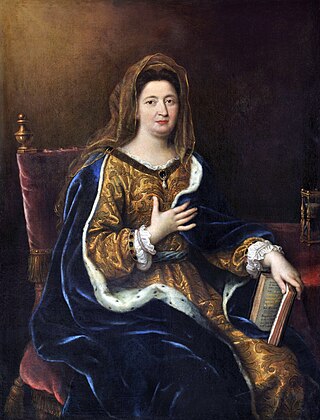
Françoise d'Aubigné, known first as Madame Scarron and subsequently as Madame de Maintenon, was a French noblewoman who secretly married King Louis XIV. Although she was never considered queen of France, she was one of the King's closest advisers and the royal children's governess. In 1686, she founded the Maison royale de Saint-Louis, a school for girls from poorer noble families.
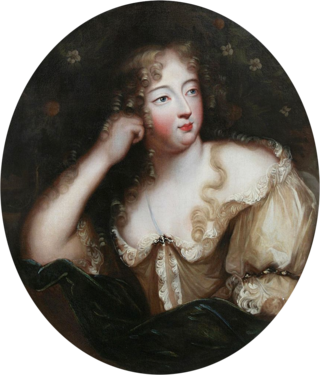
Françoise-Athénaïs de Rochechouart de Mortemart, Marquise of Montespan was the most celebrated maîtresse-en-titre of King Louis XIV, by whom she had seven children.

Françoise Louise de La Vallière, Duchess of La Vallière andVaujours, born Françoise Louise de La Baume Le Blanc de La Vallière, Mademoiselle de La Vallière was a French noblewoman and the first mistress of Louis XIV of France from 1661 to 1667. She was created suo jure Duchess of La Vallière and Duchess of Vaujours. After leaving the royal court, Louise dedicated her life to religion, becoming a nun in 1674.

Hortense Mancini, Duchess of Mazarin, was a niece of Cardinal Mazarin, chief minister of France, and a mistress of Charles II, King of England, Scotland, and Ireland. She was the fourth of the five famous Mancini sisters, who, along with two of their female Martinozzi cousins, were known at the court of King Louis XIV of France as the Mazarinettes.

Anne Marie Martinozzi, Princess of Conti was a French aristocrat and court official. She was a niece of King Louis XIV of France's chief minister Cardinal Mazarin, and the wife of Armand de Bourbon, Prince of Conti. She became the mother of the libertine François Louis, Prince of Conti, le Grand Conti. Her marriage to the Prince of Conti made her a princesse du Sang. She served as Surintendante de la Maison de la Reine for the queen dowager, Anne of Austria, between 1657 and 1666.
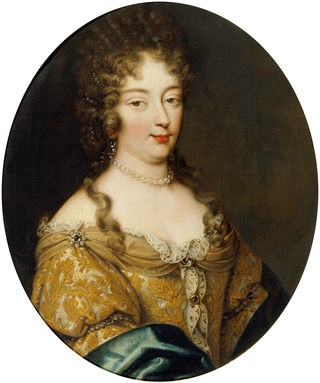
Olympia Mancini, Countess of Soissons was the second-eldest of the five celebrated Mancini sisters, who along with two of their female Martinozzi cousins, were known at the court of King Louis XIV of France as the Mazarinettes because their uncle was Louis XIV's chief minister, Cardinal Mazarin. Olympia was later to become the mother of the famous Austrian general Prince Eugene of Savoy. She also involved herself in various court intrigues including the notorious Affair of the Poisons, which led to her expulsion from France.
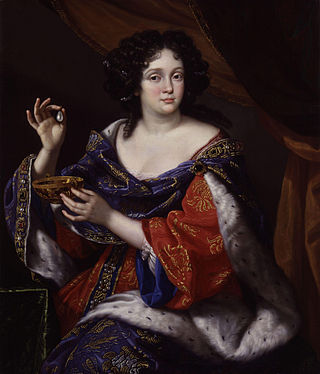
Marie Anne Mancini, Duchess of Bouillon, was an Italian-French aristocrat and cultural patron, the youngest of the five famous Mancini sisters, who along with two of their female Martinozzi cousins, were known at the court of Louis XIV, King of France as the Mazarinettes, because their uncle was the king's chief minister, Cardinal Mazarin. She is known for her involvement in the famous Affair of the Poisons, and as the patron of La Fontaine.

Anna Maria (Marie) Mancini was the third of the five Mancini sisters; nieces to Cardinal Mazarin who were brought to France to marry advantageously. Along with two of their female Martinozzi cousins, the Mancini sisters were known at the court of King Louis XIV of France as the Mazarinettes. Marie is an ancestor of Queen Paola of Belgium.

Françoise Marie de Bourbon was the youngest illegitimate daughter of King Louis XIV of France and his maîtresse-en-titre, Françoise-Athénaïs de Rochechouart, Marquise de Montespan. At the age of 14, she married her first cousin Philippe d'Orléans, the future regent of France during the minority of Louis XV. Through two of her eight children, she became the ancestress of several of Europe's Roman Catholic monarchs of the 19th and 20th centuries—notably those of Belgium, Italy, Portugal, Spain, and France.

The King is Dancing is a 2000 costume drama by Belgian filmmaker Gérard Corbiau based on Philippe Beaussant's biography of Jean-Baptiste Lully, Lully ou le musicien du soleil (1992). The film, presenting libertine and pagan Lully as a natural ally of the early Enlightenment figure Louis XIV of France in his conflicts with the Catholic establishment, focuses on Lully's personal relationship with the King, as well as his camaraderie with Molière and rivalry with Robert Cambert.

The maîtresse-en-titre was the chief royal mistress of the King of France. The title was vaguely defined and used in the Middle Ages but finally became an acknowledged office during the reign of Henry IV and continued through the reign of Louis XV. It was a semi-official position which came with its own apartments, estates and a title if the woman did not have any. The position could come with significant power, even more influence than the Queen of France, as some mistresses were known to advise the King of France sometimes in state affairs if he was so infatuated, broker favors for clients, elevate others in social mobility, forge alliances and negotiate with foreign diplomats all the while supplying the king his emotional and physical needs at the same time enriching themselves in the relationship. In contrast, the title petite maîtresse was the title of a mistress who was not officially acknowledged.

A prince du sang or prince of the blood is a person legitimately descended in male line from a sovereign. The female equivalent is princess of the blood, being applied to the daughter of a prince of the blood. The most prominent examples include members of the French royal line, but the term prince of the blood has been used in other families more generally, for example among the British royal family and when referring to the Shinnōke in Japan.

Marie Victoire Sophie de Noailles, Countess of Toulouse, was a French noble and courtier. Her second spouse was Louis Alexandre de Bourbon, Count of Toulouse, the youngest legitimized son of King Louis XIV of France and his maîtresse-en-titre, Madame de Montespan.

Philippe Jules Mancini, 8th Duke of Nevers (1641–1707) was the nephew of Cardinal Mazarin, chief minister of France immediately after the death of King Louis XIII. He was the brother of the five famous Mancini sisters, who, along with two of their female Martinozzi cousins, were known at the court of King Louis XIV of France as the Mazarinettes.

The Taking of Power by Louis XIV, also called The Rise of Louis XIV, is a 1966 French television film by Italian film director Roberto Rossellini.

Gabrielle de Rochechouart de Mortemart, Marchioness of Thianges was a French noblewoman. A great beauty and wit, she was the older sister of Françoise de Rochechouart de Mortemart, Madame de Montespan.
Louis de Pardaillan de Gondrin was a French nobleman. He was a grandson of Madame de Montespan. He was known as the marquis de Gondrin during his lifetime.

César Phoebus d'Albret, comte de Miossens, was a French soldier, a Marshal of France under Louis XIV, and a court gallant. He was also a cousin of the marquise de Montespan. His faithful attachment to Anne of Austria and Cardinal Mazarin during the Fronde, rather than any military talent, motivated his designation as a marshal of France. He set aside the name of Miossens for the grander name of Albret.
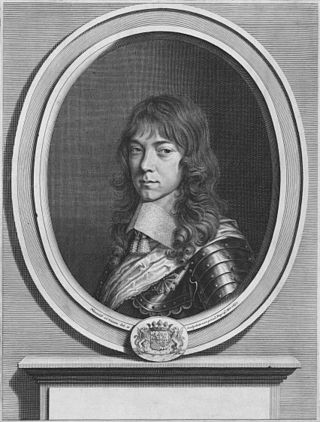
Godefroy Maurice de La Tour d'Auvergne, Duke of Bouillon was a French nobleman and member of the House of La Tour d'Auvergne, one of the most important families in France at the time. He married Marie Anne Mancini, niece of Cardinal Mazarin and had seven children.


















